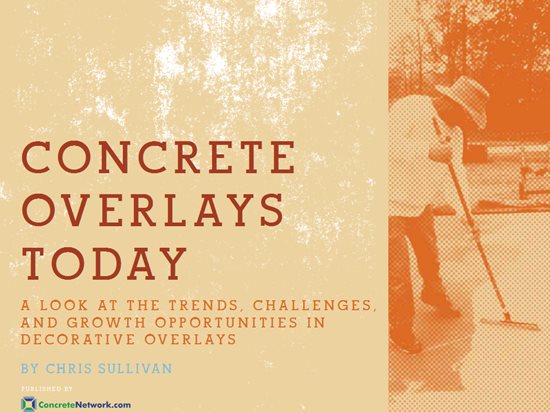- Coloring Supplies
- Concrete Stains
- Concrete Dyes
- Color Hardener
- Integral Color
- Resurfacing & Overlays
- Concrete Coatings
- Concrete Overlay Supplies
- Concrete Resurfacer
- Vertical Concrete Overlays
- Terrazzo Flooring
- Concrete Countertops
- Countertop Mixes & Supplies
- Texturing & Patterns
- Concrete Stamps
- Concrete Stencils
- Concrete Engraving
- Forms & Molds
- Concrete Forms
- Concrete Molds
- Step Forms
- Concrete Polishing
- Polishing Equipment
- Concrete Densifiers
- Tools & Equipment
- Surface Preparation
- Concrete Tools
- Concrete Power Tools
- Concrete Pumps
- Protection & Repair
- Concrete Sealer
- Cleaning Concrete
- Concrete Repair
- Curing Concrete
- Vapor Barriers
- Foundation Waterproofing
- Concrete Mix
- Concrete Admixtures
- GFRC Mixes & Supplies
Polishable Concrete Overlays
Polishable overlays are the hottest trend in the decorative overlay marketplace todayThis is an excerpt from the new e-book “Concrete Overlays Today,” part of a series of reports from ConcreteNetwork.com on trends and insights about decorative concrete applications.
Free E-book:
Concrete Overlays Today
Discover seven rising trends in the overlay industry from ConcreteNetwork.com’s new e-book. You’ll get insights and advice from veteran overlay installers that will help you find success in today’s market.
Download Concrete Overlays Today (PDF)
Considering the popularity of polished concrete and overlays in general, putting the two together is sure to spawn a popular new decorative product. “Polishable overlays are the big trend in the market,” says Trevor Foster, western sales manager with Miracote Products. Polishable overlays can either be self-leveling or trowel applied, but the result is the same -- a seamless flooring product that looks and feels like polished concrete or terrazzo.
George Rankin, owner of GLC3, Plantation, Fla., is working 6 to 7 days a week servicing the demand for polishable overlays. “We provide the look of concrete with a ½-inch overlay that achieves 7300 psi,” he says. GLC3 utilizes a system that allows them to prepare the floor in one day, install and power trowel the overlay the next day, and polish the surface the third day. This fast-track system is what his customers want and one of the real benefits of a polishable overlay. Rankin feels that the polishable overlay market will only grow in coming years. “Everyone is in a hurry, and we provide a quality product that fits that need.”
Another area where polishable overlays are making a difference is with the green movement. Because they increase the reflectance of the floor, which decreases the need for artificial light, they help to contribute toward LEED points on green projects. The smooth, dense, polished topping is also easy to clean, reducing maintenance. Because of these attributes, polished overlays are taking market share from carpet and other flooring materials, especially in commercial settings.
Polishable overlays also fit nicely into current design trends. These systems can be seeded with different types of aggregate or colored glass, allowing them to look and perform like traditional terrazzo but at a much lower price. Terry Grimble, director of technical services for Bomanite Company, says their company has been successfully promoting these types of systems for interior commercial work for years. “When you look at what we are competing against, we see a real advantage with some of these decorative overlay systems.”
Despite their popularity, polishable overlays might not be for everyone. The skill level required for installation is high. Not only do you have to be qualified in the installation of self-leveling or trowel-grade overlays, you also have to have expertise in polishing. The equipment required to perform this type of installation can run as high as $30,000, plus the cost of a skilled operator. When you consider everything that goes into a polished overlay project - surface preparation, primer, overlay, and labor - any type of failure, no matter how small, can lead to large liability issues.
While the polishable overlay market is hot, Foster says it’s just getting warmed up. There is still room for new product innovations that will change this market segment over the next few years. “I see decorative overlays, and especially polishable toppings, as a still-developing product segment,” he says.
Related information:
Polished Concrete Overlays
Concrete Overlays
Return to Concrete Overlays Today





